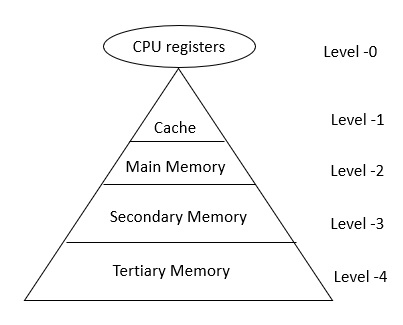
 Data Structure
Data Structure Networking
Networking RDBMS
RDBMS Operating System
Operating System Java
Java MS Excel
MS Excel iOS
iOS HTML
HTML CSS
CSS Android
Android Python
Python C Programming
C Programming C++
C++ C#
C# MongoDB
MongoDB MySQL
MySQL Javascript
Javascript PHP
PHPPhysics
Chemistry
Biology
Mathematics
English
Economics
Psychology
Social Studies
Fashion Studies
Legal Studies
- Selected Reading
- UPSC IAS Exams Notes
- Developer's Best Practices
- Questions and Answers
- Effective Resume Writing
- HR Interview Questions
- Computer Glossary
- Who is Who
What is memory hierarchy?
The Computer memory hierarchy looks like a pyramid structure which is used to describe the differences among memory types. It separates the computer storage based on hierarchy.
Level 0: CPU registers
Level 1: Cache memory
Level 2: Main memory or primary memory
Level 3: Magnetic disks or secondary memory
Level 4: Optical disks or magnetic types or tertiary Memory

In Memory Hierarchy the cost of memory, capacity is inversely proportional to speed. Here the devices are arranged in a manner Fast to slow, that is form register to Tertiary memory.
Let us discuss each level in detail:
Level-0 − Registers
The registers are present inside the CPU. As they are present inside the CPU, they have least access time. Registers are most expensive and smallest in size generally in kilobytes. They are implemented by using Flip-Flops.
Level-1 − Cache
Cache memory is used to store the segments of a program that are frequently accessed by the processor. It is expensive and smaller in size generally in Megabytes and is implemented by using static RAM.
Level-2 − Primary or Main Memory
It directly communicates with the CPU and with auxiliary memory devices through an I/O processor. Main memory is less expensive than cache memory and larger in size generally in Gigabytes. This memory is implemented by using dynamic RAM.
Level-3 − Secondary storage
Secondary storage devices like Magnetic Disk are present at level 3. They are used as backup storage. They are cheaper than main memory and larger in size generally in a few TB.
Level-4 − Tertiary storage
Tertiary storage devices like magnetic tape are present at level 4. They are used to store removable files and are the cheapest and largest in size (1-20 TB).
Let us see the memory levels in terms of size, access time, bandwidth.
| Level | Register | Cache | Primary memory | Secondary memory |
| Bandwidth | 4k to 32k MB/sec | 800 to 5k MB/sec | 400 to 2k MB/sec | 4 to 32 MB/sec |
| Size | Less than 1KB | Less than 4MB | Less than 2 GB | Greater than 2 GB |
| Access time | 2 to 5nsec | 3 to 10 nsec | 80 to 400 nsec | 5ms |
| Managed by | Compiler | Hardware | Operating system | OS or user |
Why memory Hierarchy is used in systems?
Memory hierarchy is arranging different kinds of storage present on a computing device based on speed of access. At the very top, the highest performing storage is CPU registers which are the fastest to read and write to. Next is cache memory followed by conventional DRAM memory, followed by disk storage with different levels of performance including SSD, optical and magnetic disk drives.
To bridge the processor memory performance gap, hardware designers are increasingly relying on memory at the top of the memory hierarchy to close / reduce the performance gap. This is done through increasingly larger cache hierarchies (which can be accessed by processors much faster), reducing the dependency on main memory which is slower.

